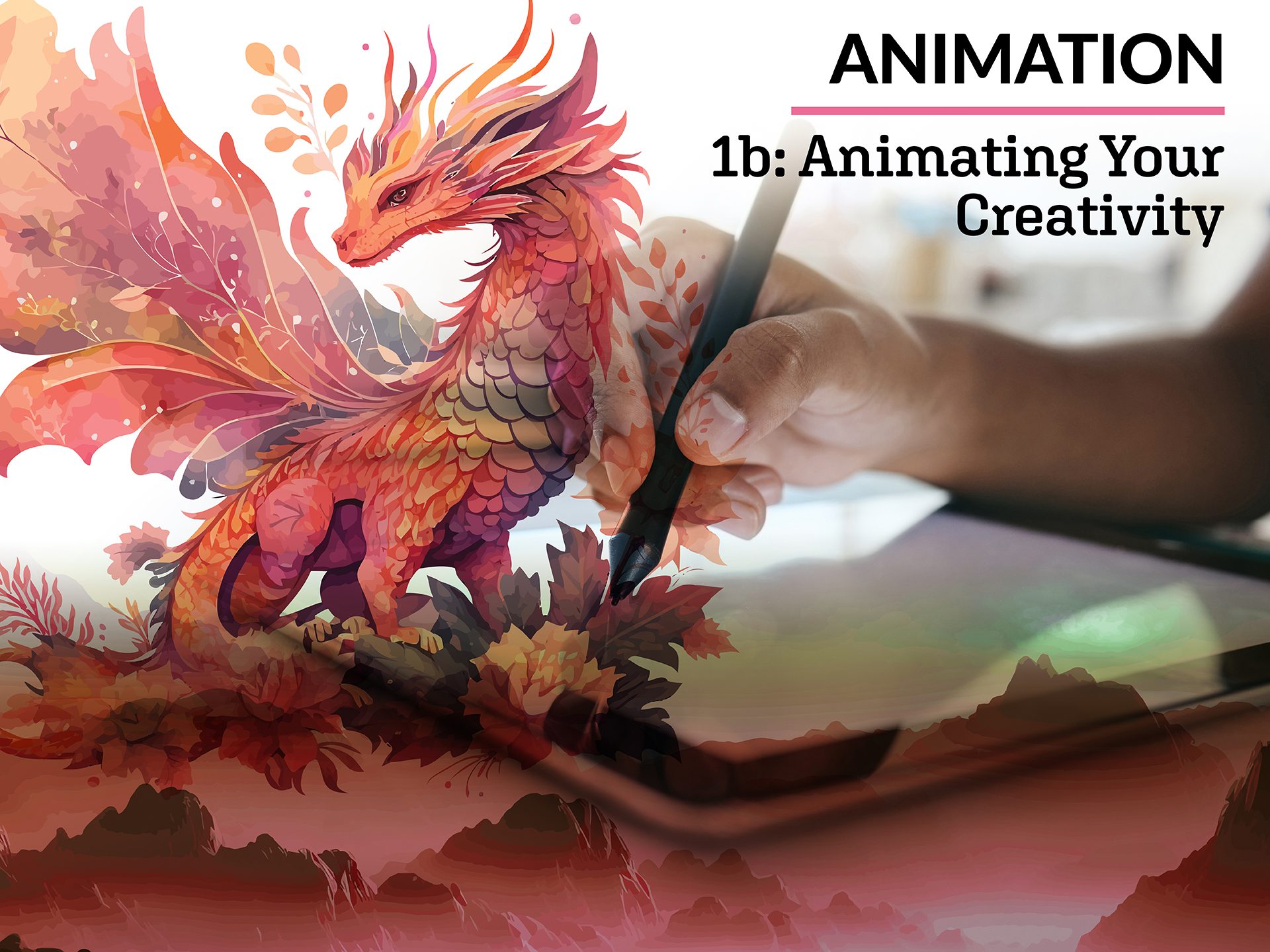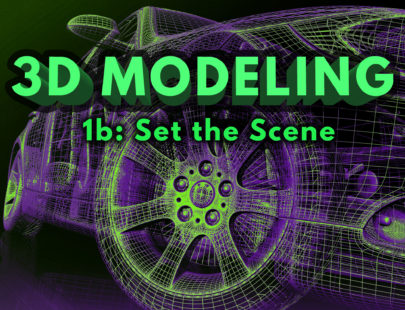
Animation 1b: Animating Your Creativity
Ready to turn your ideas into amazing animations? In this course, you will learn everything from basic shapes to crafting stories and developing characters with personality. You will explore 3D animation, discovering how to make storyboards, set up cameras, use tools like lighting, texturing, and rendering to make your work stand out. But that’s not all – you will also add sound, like music, effects, and ambient noise, to make your animations come alive. Whether you’re just starting out or levelling up your skills, this course will help you create animations that are professional-quality and awesome.
Units at a Glance
Unit 1: Writing for Animation
Much like an artist mixing colors on a palette and carefully making strokes to create a masterpiece, an animator must choose the words to write a story for animation. But it’s not as simple as just typing away. Whether you’re scripting a heartwarming short or an epic saga, you need to be able to transform your ideas into enchanting animations that resonate with audiences. In this unit, you’ll learn the basics of storytelling, genre, scriptwriting, character development, and character design. You’ll also learn the screenwriting conventions for setting a scene, announcing characters, and writing dialogue. You’ll become a writing wizard able to conjure characters, worlds, and adventures from thin air, just by using words.
What will you learn in this unit?
- Recognize the elements of stories and plots
- Incorporate genre-specific storytelling techniques
- Create character profiles for animation
- Format a script using common conventions and software
Unit 2: Designing for Animation
What do design and animation have in common? Way more than you might think! Design is as much a part of the animation process as any animation skill. It’s time to tap into your inner designer as you tackle character design, storyboard design, animatic design, and background environment design. You’ll learn how each of these design skills will sharpen your storytelling abilities and prepare you with industry skills for a career in animation.
What will you learn in this unit?
- Develop a character’s design from a character profile
- Storyboard a script for animation
- Evolve a storyboard into an animatic
- Design an environment for an animation
Unit 3: Advanced Texturing and Rigging
You can apply a texture to models, and you can rig a character for animation, but what do you do when a 3D object needs multiple materials, or what if the character has an unusual anatomy? What if you want to create a 2D animation effect on a 3D model? In this unit, you will level up your texturing and rigging skills. And this will help you develop the skills to tackle special challenges with ease!
What will you learn in this unit?
- Create and apply procedural materials to a model
- Use material slots to apply multiple materials to a model
- Simulate cel animation using Grease Pencil
- Develop a Spline IK rig for a model
Unit 4: Advanced Cameras and Lighting
Imagine animating a nighttime car chase scene in which the camera can respond and follow the action dynamically. As the chase progresses, the camera shifts seamlessly between multiple perspectives around the scene to heighten the intensity. Now, picture adding realistic lighting that flashes across the reflective surfaces of the cars, bringing your scene to life. In this unit, you’ll tackle mastering cameras, learning how to position and animate them to fit the needs of your scenes. You’ll also dive deeper into lighting techniques and animation for more sophisticated lighting that changes to match the moods of your scenes.
What will you learn in this unit?
- Apply fundamental camera principles, types, and placements
- Follow the action and switch perspectives by animating cameras
- Utilize advanced lighting techniques for mood and realism
- Animate light properties and implement HDRI lighting
Unit 5: Advanced Rendering
Imagine you are an animation director aiming to create a visually stunning sci-fi cityscape for a futuristic film. The city lights need to shimmer with realistic reflections, and the edges of every building should be crisp and clear, drawing the viewer into the meticulously crafted world. Mastering advanced rendering techniques is your key to bringing this scene to life. Understanding how to manipulate light, shadows, and transparency will elevate the quality of your animation. This knowledge will empower you to produce professional-quality animations that stand out. In this unit, you’ll explore advanced rendering concepts and techniques, setting the stage for your journey into high-level animation rendering. Let’s dive into the fascinating world of rendering light, edges, transparency, and optimization.
What will you learn in this unit?
- Apply global illumination and anti-aliasing techniques to create realistic and smooth animation
- Use alpha channels for effective transparency and compile image sequences into movies
- Optimize renders with multi-pass, batch, and net rendering for efficient workflow
- Render animations with safe zones and produce low-quality reference animations for pre-visualization
Unit 6: Adding Sound to Your Animation
Great animation not only looks stunning but also sounds spectacular! Sound is the secret ingredient that transforms a good animation into an unforgettable experience. In this unit, you’ll unlock the power of sound to elevate your storytelling, making your characters and scenes come to life with energy and emotion. Whether it’s the suspenseful creak of a door, the dramatic swell of music, or the perfect voiceover that captures a character’s essence, you’ll learn how to craft audio that resonates with your audience. By the end of this unit, you’ll have the tools and techniques to ensure that your animation is not just seen but is also truly heard, creating an experience that stays with your viewers long after the credits roll.
What will you learn in this unit?
- Identify and apply various types of sounds used in animation
- Design and edit ethically sourced sounds in Audacity
- Integrate synchronized voice acting into animation
- Combine sound, graphics, and images in Blender
Unit 7: Post-Production for Animation
Prepare to step into the final frontier of animation creation: post-production! In this unit, you’ll discover where the true magic of animation happens. With your foundation built, it’s time to bring everything together—and add those finishing touches that will elevate your animation from good to unforgettable. You’ll dive into the technical wizardry of VFX, mastering particle systems and the art of layer-based compositing. But it’s not just about the tools—it’s about how they empower your creative decisions, allowing you to tell more compelling stories and craft stunning visual experiences. By the end of this unit, you’ll know how to integrate these techniques seamlessly and choose the right delivery methods to show your animated masterpieces to the world.
What will you learn in this unit?
- Understand the stages of post-production in animation and utilize time management strategies and workflow efficiencies
- Design particle systems in Blender to create dynamic visual effects
- Apply layer-based compositing techniques to increase the visual appeal and depth of your scenes
- Select and implement appropriate delivery methods for distributing and showcasing the final cut of your animation project
Unit 8: Building Your Animation Career
In this final unit, you’ll transform from a student into a career-ready professional. Everything you’ve learned so far will come together as you prepare to launch your creative talents in the animation world. You’ll master the art of communicating with confidence, leading teams with integrity, and showcasing your unique skills through a polished portfolio that sets you apart in the competitive animation industry. Whether you dream of landing your first job, starting your own studio, or simply exploring what’s next, this unit will give you the tools to make your mark. You’ll focus on both technical skills and the soft skills that employers seek so that you’ll finish this course ready to embrace every opportunity the animation world has to offer and confidently step into your career!
What will you learn in this unit?
- Demonstrate adaptive communication skills and ethical practices
- Apply leadership, teamwork, and problem-solving skills in collaborative animation environments
- Identify and evaluate job opportunities in animation
- Understand the importance of continuous learning and soft skills in maintaining career growth
Required Materials
Software
- Blender 3.6.X LTS
- Word processing software
Other
- Flixier website
- Helpers (3)
- Portfolio hosting website
Optional
- Audio recording device
- Graphic design software
- Presentation software
- Writing supplies



